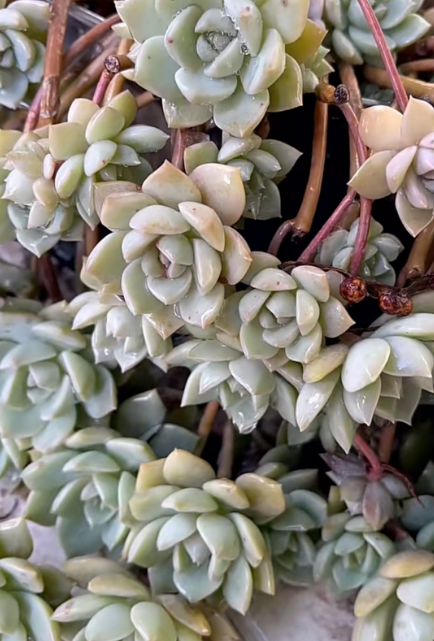In fact, the appearance of lateral buds on succulent plants is a delightful phenomenon, indicating that the plant is full of vitality and in good health. As the lateral buds gradually grow, the original single - stemmed succulent will turn into a cluster - growing state, with layers of leaves and more vivid colors. It looks especially beautiful whether it is potted individually or combined with other plants in a display. Moreover, when these lateral buds grow up, they can be cut off and used for cutting, enabling the reproduction of new plants without additional cost, which kills two birds with one stone.
However, if there are too many lateral buds, there will be problems. For example, the lateral buds compete with the mother plant for nutrients, which may lead to the slow growth of the mother plant, thinner leaves, and in severe cases, withering. In addition, overly dense lateral buds can cause poor ventilation inside the plant, making it prone to germ growth. They can also grow spindly due to insufficient light, affecting the plant's appearance. Therefore, when the lateral buds grow to a certain size, they need to be properly pruned. Remove the weak or poorly - positioned buds and keep the strong ones to ensure the healthy growth of both the mother plant and the lateral buds. Remember to use clean scissors when pruning and apply some carbendazim to the wound after cutting to prevent infection.
Take Echeveria 'White Peony' as an example. This kind of succulent is prone to producing lateral buds. However, to make it produce more and more evenly distributed lateral buds, several tips need to be mastered. First is lighting. Echeveria 'White Peony' should be exposed to the sun for at least 4 - 6 hours a day. In spring and autumn, it can be directly placed on the balcony or windowsill. In summer, when it is too sunny, use a sun - shading net to block half of the sunlight. In winter, try to place it near the south - facing window indoors. If the light is insufficient, a supplementary light can be used to help.
Regarding watering, Echeveria 'White Peony' is drought - tolerant. During the growth period, it is advisable to water thoroughly when the soil is completely dry. In summer and winter, the frequency of watering should be reduced. Water once every 10 - 15 days in summer and once every 20 - 30 days in winter. Choose to water in the morning or evening, avoiding the high temperature at noon and the low temperature at night. Appropriate water control can make Echeveria 'White Peony' feel "survival pressure", making it more likely to produce lateral buds. However, do not let it lack water for too long, otherwise it will wither.
Fertilization is also crucial. During the growth period, apply a thin, specialized succulent fertilizer every 20 - 30 days, such as a nitrogen - phosphorus - potassium compound fertilizer. Among them, phosphorus and potassium fertilizers can promote the differentiation of lateral buds. When fertilizing, dissolve the fertilizer in water and pour it along the edge of the flowerpot, keeping the fertilizer away from the leaves. Echeveria 'White Peony' grows slowly in winter and summer, so it is advisable to avoid fertilizing to prevent root burning.
If you want to make Echeveria 'White Peony' produce lateral buds quickly, you can try pinching or decapitation. Pinching means gently pinching off the top buds with your fingers or scissors to break the apical dominance and concentrate the nutrients on the lateral buds. Decapitation involves cutting off the upper part of the stem with a sharp knife, leaving 3 - 5 centimeters at the base. In this way, multiple lateral buds will emerge from the base. These two methods are best carried out in spring and autumn. After treatment, place the plant in a ventilated and cool place. Water less before the wound heals and expose it to more sunlight to promote the growth of lateral buds.
Temperature difference can also stimulate the growth of lateral buds in Echeveria 'White Peony'. In spring and autumn, the outdoor temperature difference between day and night is large, so it can be directly placed outdoors for cultivation. If it is indoors, you can open the window for ventilation at night or place it in an air - conditioned room to maintain a temperature difference of about 10°C. However, if the temperature difference is too large, the plant may be frost - bitten, so it is necessary to pay attention to control.
The selection of soil and flowerpots is also very important. Echeveria 'White Peony' prefers loose and breathable soil. You can mix peat soil, perlite, and vermiculite in a ratio of 3:3:2 and add some volcanic stone or medical stone to increase the air permeability. The flowerpot should be selected according to the size of the plant. It should have drainage holes at the bottom, and the diameter should be 1 - 2 centimeters larger than that of the plant. If it is too large, it is prone to water accumulation; if it is too small, it will limit the growth of the roots.
Finally, it should be noted that it takes time for succulents to produce lateral buds. Don't be impatient. Follow the above - mentioned methods to take care of them patiently. Usually, observe the state of the plant more. After the lateral buds grow out, be careful not to damage them. When they grow larger, they can be divided for reproduction, turning Echeveria 'White Peony' into a beautiful cluster - growing potted plant. As long as you master these skills, your Echeveria 'White Peony' can also easily produce lateral buds and become more and more lush!
Is it a good thing for succulents to produce lateral buds?

Share with
Tagged in :




Leave a Reply